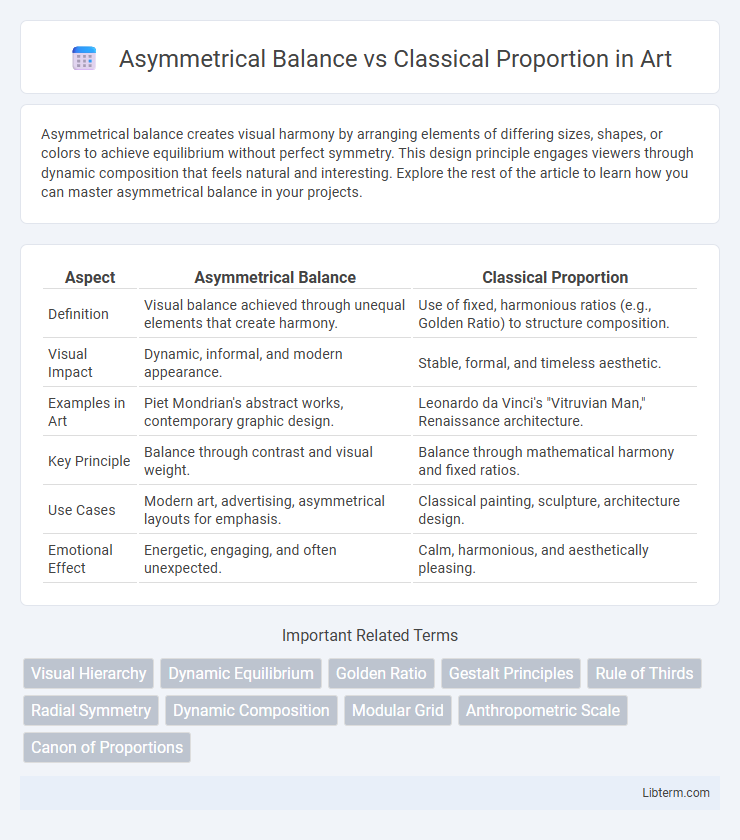Asymmetrical balance creates visual harmony by arranging elements of differing sizes, shapes, or colors to achieve equilibrium without perfect symmetry. This design principle engages viewers through dynamic composition that feels natural and interesting. Explore the rest of the article to learn how you can master asymmetrical balance in your projects.
Table of Comparison
| Aspect | Asymmetrical Balance | Classical Proportion |
|---|---|---|
| Definition | Visual balance achieved through unequal elements that create harmony. | Use of fixed, harmonious ratios (e.g., Golden Ratio) to structure composition. |
| Visual Impact | Dynamic, informal, and modern appearance. | Stable, formal, and timeless aesthetic. |
| Examples in Art | Piet Mondrian's abstract works, contemporary graphic design. | Leonardo da Vinci's "Vitruvian Man," Renaissance architecture. |
| Key Principle | Balance through contrast and visual weight. | Balance through mathematical harmony and fixed ratios. |
| Use Cases | Modern art, advertising, asymmetrical layouts for emphasis. | Classical painting, sculpture, architecture design. |
| Emotional Effect | Energetic, engaging, and often unexpected. | Calm, harmonious, and aesthetically pleasing. |
Understanding Asymmetrical Balance
Asymmetrical balance achieves visual harmony by distributing elements of varying weights, shapes, and textures unevenly yet cohesively across a composition, creating dynamic interest without relying on mirror symmetry. Unlike classical proportion, which uses fixed ratios such as the golden ratio or the rule of thirds to achieve balance through symmetry and predictability, asymmetrical balance focuses on the relationship between contrasting components to maintain equilibrium. This approach allows for more flexibility and creativity in design, emphasizing contrast, movement, and tension while still ensuring the overall composition feels stable and unified.
Defining Classical Proportion
Classical proportion is rooted in ancient Greek and Roman architecture, emphasizing harmonious ratios based on mathematical precision and symmetry, such as the Golden Ratio. It prioritizes balanced and predictable structures where elements maintain a consistent size and alignment to create visual stability. This approach contrasts with asymmetrical balance, which achieves harmony through varied, uneven distribution of visual elements.
Historical Context: Evolution of Design Principles
Asymmetrical balance and classical proportion represent two distinct historical design principles that evolved alongside cultural shifts. Classical proportion, rooted in ancient Greek and Roman aesthetics, emphasizes harmony and mathematical ratios such as the Golden Ratio, influencing Renaissance architecture and art. In contrast, asymmetrical balance gained prominence during the modernist movement of the 20th century, reflecting a break from traditional symmetry and embracing dynamic, visually engaging compositions.
Visual Impact: Asymmetry vs. Symmetry
Asymmetrical balance creates dynamic visual interest by distributing elements unevenly while maintaining harmony, engaging the viewer with movement and tension. Classical proportion relies on symmetry and mathematical ratios such as the Golden Ratio, producing a sense of order, stability, and timeless beauty. The contrast between asymmetry and symmetry influences emotional responses, where asymmetry evokes energy and creativity, whereas classical proportion conveys calmness and formality.
Psychological Effects on the Viewer
Asymmetrical balance creates a dynamic and engaging visual experience by introducing tension and movement, stimulating curiosity and emotional involvement in the viewer. Classical proportion, rooted in the Golden Ratio and symmetry, evokes feelings of harmony, stability, and aesthetic pleasure, fostering a sense of order and comfort. The psychological impact of asymmetry often leads to increased attention and intrigue, while classical proportion cultivates trust and relaxation through predictable visual patterns.
Application in Modern Architecture
Asymmetrical balance in modern architecture creates dynamic, visually engaging spaces by distributing visual weight unevenly while maintaining harmony, often seen in innovative building facades and interior layouts. Classical proportion relies on timeless ratios such as the golden mean to achieve pleasing symmetry and order, frequently applied in monumental structures and high-end residential designs. Architects combine these approaches to blend tradition with contemporary aesthetics, enhancing functional and emotional experience in urban environments.
Usage in Art and Composition
Asymmetrical balance in art creates dynamic tension by arranging visual elements of differing weights and sizes to achieve equilibrium without mirroring, often used in contemporary compositions to evoke movement or informality. Classical proportion relies on harmonious ratios and symmetry, typically based on the golden ratio or the rule of thirds, creating a sense of stability and order favored in Renaissance art and traditional design. Artists use asymmetrical balance to convey complexity and spontaneity, while classical proportion emphasizes clarity and timeless beauty in composition.
Advantages of Asymmetrical Balance
Asymmetrical balance offers dynamic visual interest by creating a sense of movement and variety that classical proportion often lacks. It allows for more creative freedom in design, accommodating diverse elements without strict adherence to symmetry, which can lead to innovative and engaging compositions. This approach also enhances adaptability in various media, making spaces or visuals feel more natural and less predictable compared to the rigid structure of classical proportion.
Limitations of Classical Proportion
Classical proportion relies on fixed ratios such as the golden mean, which can limit creative flexibility and adaptability in modern design. It often imposes rigid structural rules that may not accommodate diverse visual expressions or dynamic spatial relationships. This constraint can hinder the development of innovative compositions that asymmetrical balance allows through varied, yet harmonious, element distribution.
Choosing the Right Approach for Your Project
Choosing between asymmetrical balance and classical proportion depends on the project's goals and aesthetic preferences. Asymmetrical balance offers dynamic visuals and modern appeal, perfect for creating interest without strict symmetry, while classical proportion ensures harmony and stability through established ratios like the golden mean. Evaluating the desired emotional impact and functional requirements guides the selection of the ideal design approach.
Asymmetrical Balance Infographic

 libterm.com
libterm.com